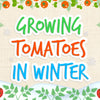What Causes Tomato Leaves To Curl? The Full Guide
Tomato plant leaves respond to various stresses by rolling or curling up. The stress could either be environmental, biological or chemical related.
Leaf curl can be quite frustrating to deal with as multiple conditions can cause it or a combination of any and the only way to deal with it is by identifying the exact cause. The symptoms are also usually delayed for up to 3 weeks meaning that your plants will have been affected for an extended period before the leaf curl shows up (link).
Not Much Time? Skip To What You'd Like To Learn...
Reasons Why Tomato Leaves Curl
Physiological Leaf Roll
Causes:
Physiological leaf curl occurs when the tomato plant undergo vigorous top growth coupled with inadequate root growth.
This is by far the most common form of leaf curl and is a growth response to environmental conditions. As a result, the roots fail to keep up with the water and nutrition demand from the leaves. Other factors that may result in physiological leaf roll include transplant shock, root injury, over pruning, phosphate deficiency and high nitrogen intake.
Symptoms:
Physiological leaf roll can be identified by its characteristics whereby the lower and older leaves will have an upward curl followed by an inward curl towards the mid-vein. This condition then spreads gradually towards the upper shoots, but the leaves still maintain their natural green color.
Chemical Injury
Causes:
Chemical injury leaf curl can occur when there’s herbicide residue in mulch or compost that was made with manure previously exposed to long-term herbicides such as Grazon which can persist for up to 18 months.
Tomato plants are highly sensitive to hormone-based herbicides, insecticides, and fungicides. While some of these chemicals are required at some point, it’s all about the amount of exposure. It's also important to remember that most of these chemicals can be transferred from nearby farms by strong winds.
Symptoms:
Standard symptoms of chemical injury include downward rolling leaves which can also be twisted, split stems with yellowed or chlorotic and malformed fruits.
Extreme Weather Conditions
Causes:
High winds especially when accompanied by low humidity and dusty conditions will automatically trigger leaf curl.
Tomato plants rely on leaf curl as a self defense response to extreme weather conditions. This response prevents further water loss from the plant’s leaves. The same response will kick in if you fail to water your plants frequently. Tomatoes are also sensitive to excess moisture such as during rainy weather accompanied by cold temperatures.
Symptoms:
In such conditions, the leaves will generally turn leathery, thicken and curl inwards. This can be used to differentiate weather-related leaf curl from other conditions.
Leaf Curl Virus
Causes:
Tomato Yellow Leaf Curl Virus (TYLCV) and Tobacco Mosaic Virus (TMV) are the two most notorious viruses that affect tomato plants. These are spread via human contact especially if you have been in contact with tobacco and most notably by aphids and whiteflies.
Symptoms:
Leaf curl as a result of these viruses is usually accompanied by other identifying symptoms such as yellowing leaves, stunted growth, purple veins on the leaf underside and internal browning of fruits.
(link)
How to Reverse It

Just because your plants have developed leaf curl doesn’t mean that the entire crop is gone. There are various ways to reverse tomato leaf curl depending on the cause. Some may take quite a bit of time before any noticeable changes so be patient with your plants (link).
Watering Schedule and Well-Drained Soil
Physiological Leaf Curl: It advised watering your plants regularly within a set schedule. The best time to water tomatoes is during the morning hours; this ensures that the plants have enough moisture to sustain them throughout the day.
Ensure that the soil is also well drained to avoid mineral leaching which leads to leaf curl. Plants that had been previously affected by physiological leaf curl as a result of either lack of enough water or undrained soil usually recover within a few days, and the production will not even be affected if the issue is fixed on time.
Reduce Herbicide Drift
Chemical Injury: While it's almost impossible to undo the damage caused by herbicides on tomato leaves, reducing the toxicity will play a vital role in ensuring that the plant at least recovers.
Avoid spraying any chemicals when the winds are more than 5 mph. Also, use a hooded sprayer when applying post-emergence herbicides especially near growing plants. The next step in undoing herbicide damage is by reducing the concentration in the soil. This is achieved by frequent watering and ensuring that the earth is well drained. With such changes, the tomatoes should sprout new leaves without the curled effect.
Shading
Extreme Weather Conditions: The best way to deal with it when caused by extreme weather conditions is by introducing some sort of protection that will act as a buffer between the elements and your sensitive plants.
Shading will protect your tomato plants from the scorching heat of midday sun thus preventing leaf curl as a result of excessive evaporation. The shading will also protect your plants from strong winds and dust. With such insulation in place, your plants should recover almost immediately as they will no longer need to deploy the curling defensive mechanism.
Extra Nitrogen
Leaf Curl Virus: If your plants have lost much vegetation due to leaf curl, then the best way to encourage recovery is by spurring leaf growth, this can be done with extra nitrogen supply. After you have identified and dealt with the culprit responsible for the leaf curl, then a little extra Urea will encourage leaf growth to restore the balance.
Interested In Growing Tomatoes?

At grow your pantry we have developed the perfect tomato cage. It's strong, multitiered, supports growth through all stages, strong and sturdy.
[Check Out The Latest Price Here]
How to Prevent It

Pest Control
Pests such as whiteflies and broad mites affect many plant families including tomatoes and closely related plants such as potatoes and peppers. As a result, these insects can easily transmit diseases from one plant to the other.
Tomatoes are highly susceptible to TYLCV and TMV which are common in related plants.
How do I do this? To prevent the spread of these viruses, you will have to deal with the transmitting agent; the pests. Thankfully there are various ways of dealing with such. The organic methods include introducing a natural predator such as ladybugs and praying mantis. If the infestation is too widespread to deal with such natural means, you can always opt for insecticides which unfortunately will also kill the helpful insects.
Crop Rotation
One of the most natural ways of preventing virus-related leaf curl is by practicing crop rotation. Crop rotation ensures that bacteria and viruses that affect your tomatoes don’t survive to the next tomato crop as they will not be active once you plant a non-susceptible crop such as carrots or beans. This effectively stops the cycle ensuring that your future plants will be free of these viruses.
How do I do this? This involves planting a different crop variety on your garden each season. This not only improves the structure of the soil but also ensures that there’s a nutrient balance as opposed to growing the same crop repeatedly.
Proper Handling of Herbicides
How do I do this? When handling herbicides it is mandatory to follow the precautions and restrictions specified on the product label. Also, any manure and urine from farm animals that may have consumed treated forage will still contain enough herbicides to cause injury to your plants so avoid using compost from such sources.
To further prevent herbicide related leaf curl, it's recommended to promote herbicide decomposition by either burning plant residues that were exposed to herbicides or evenly incorporating them in the soil.
While such precautions might mitigate against herbicide poisoning from local sources, there’s still the possibility of the chemicals getting blown over from nearby fields to your garden. If there’s such a possibility, then the herbicide users should be encouraged to use drift-reducing spray additives.
Use Resistant Varieties
TYLCV cannot be treated entirely once it infects a plant the best you can hope for is to control the spread by eliminating the pests that spread it. However, there might be a way to avoid this catastrophe altogether; by planting resistant/tolerant variants.
How do I do this? The best variety of these includes transgenic tomatoes which are tomatoes that have had their genes modified through genetic engineering. As a result, the plants can withstand not only such viruses but also new traits are added during the process such as increased shelf life and resistance to environmental stresses.
Intercropping
Intercropping is not only a great way to make the most out of your garden, but it also helps in combating pests and diseases especially soil-borne microorganisms.
How do I do this? Marigolds are especially suitable for intercropping with tomatoes due to their qualities of repelling garden pests. The plant produces alpha-terthienyl a substance that reduces root-knot nematodes in the soil. Garlic and onions are natural aphid repellants and will, therefore, keep away this menace which is known to spread the virus.
(link)
Other Articles You'll Love...
15 Tips For Growing Tomatoes
What Causes Tomato Leaves To Curl?
How Much Sun Do Tomatoes Need?
Why Are My Tomatoes Not Turning Red?
How Far Apart To Plant Tomatoes
Why Are My Tomatoes Splitting?
-
Posted in
tomatoes







